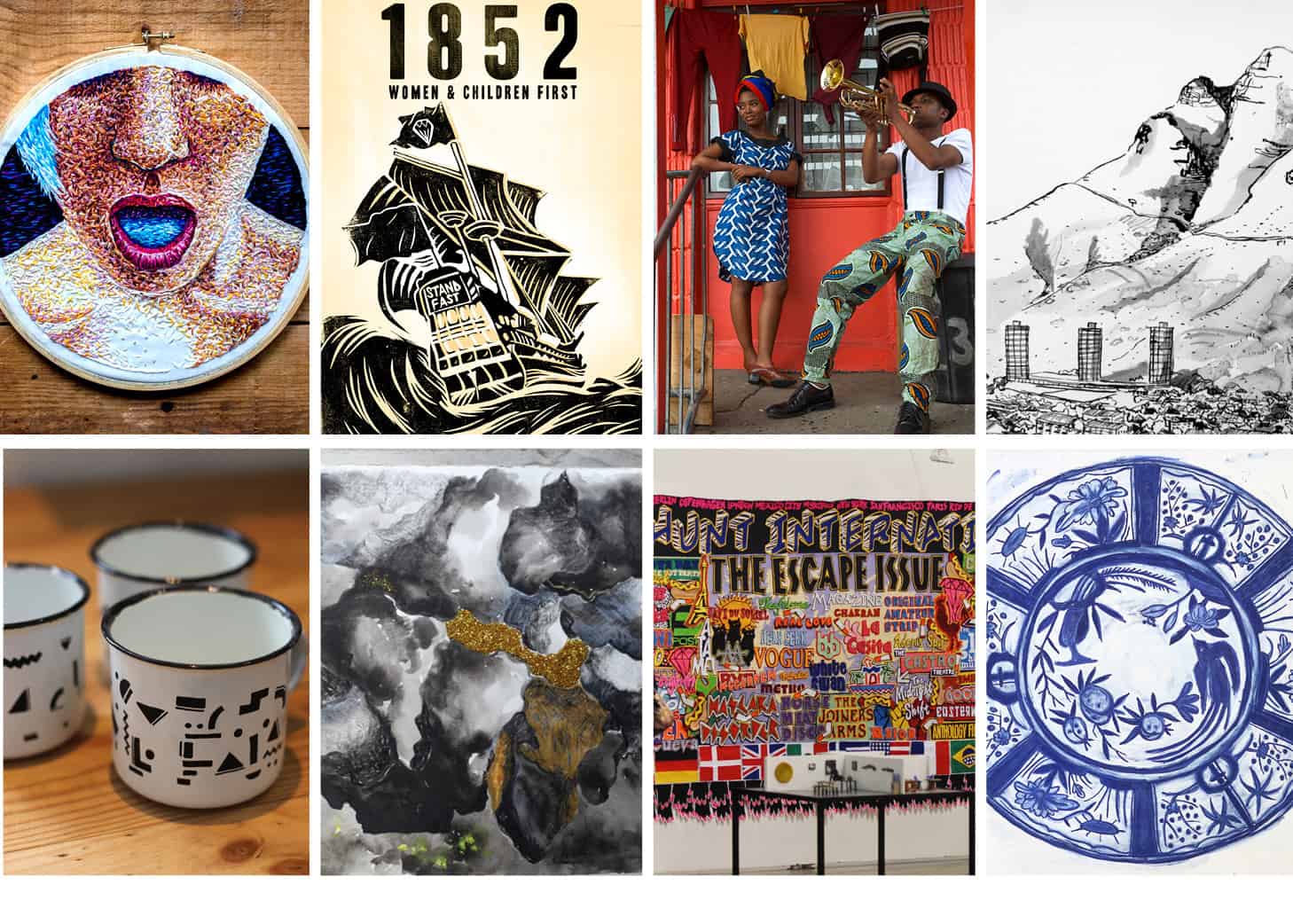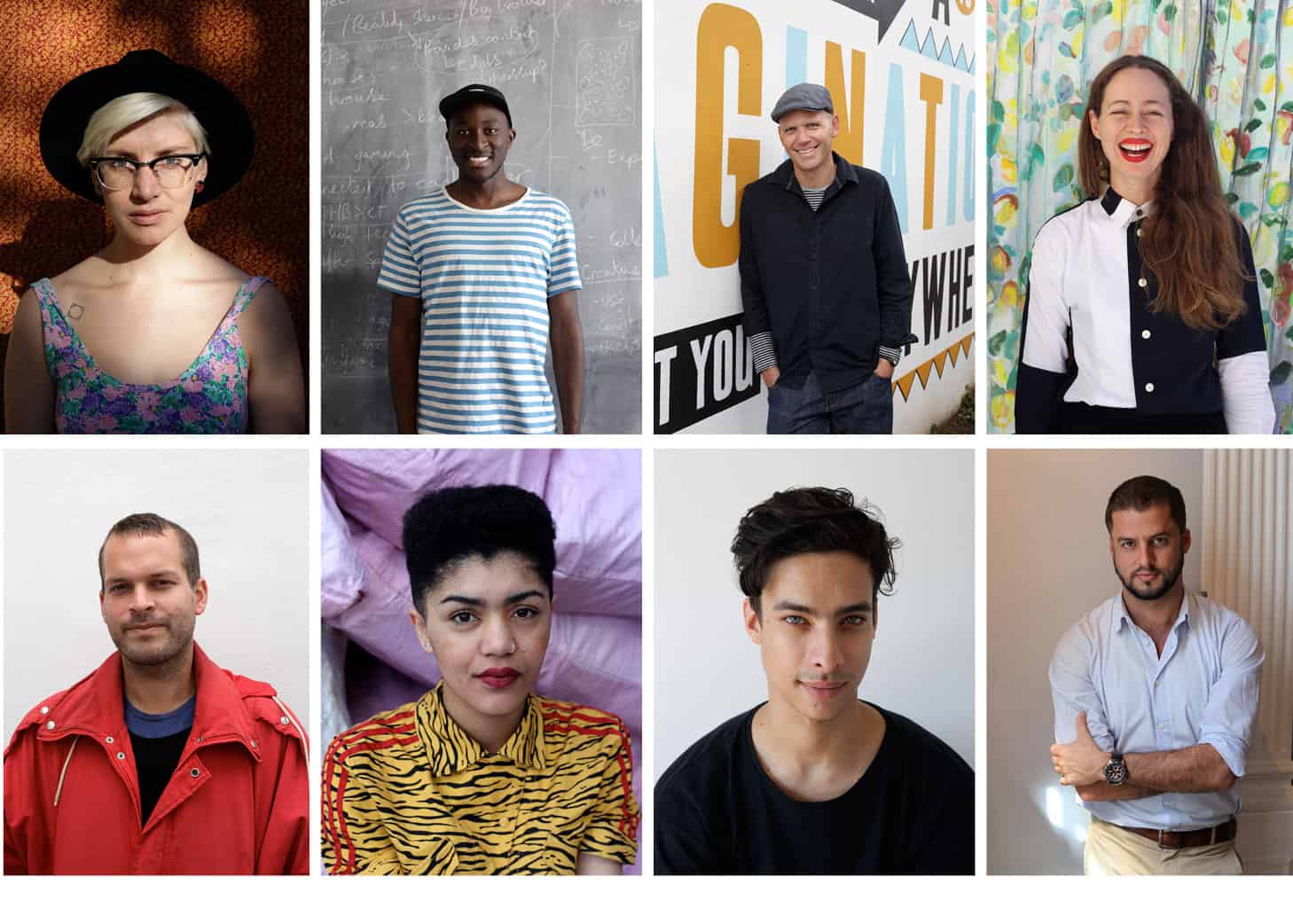While at the Residency they were asked to reflect on their surroundings and create an artwork inspired by the Mother City. The results range from watercolor paintings to a photo story, from painted enamel mugs to a felt collage. The project was documented in a series of videos shot by filmmaker Josh Hayman and published regularly throughout the five months on a pop-up channel on Between 10and5. Nokia supported the project by providing a Lumia 1520 for the artists to use during their stay to document their experience.

CLOCKWISE FROM TOP LEFT: work produced during the residency by Danielle Clough, Fort Rixon, Ed Suter, Lucie De Moyencourt, Michael Chandler, Jody Paulsen, Laura Windvogel, Sebastian Borckenhagen. Photographs courtesy of Between 10and5.
ARTsouthAFRICA spoke to each of the artists and asked them for their personal reflection on the residency.
Could you each explain the process of conceptualising and making the specific work you produced during your time at the InAWE Residency?
Danielle Clough: The only guideline for the InAWE Residency was to draw inspiration from Cape Town and I had always wanted to explore the idea of a self portrait. I find myself very much drawn to Seapoint at the moment. It’s this bubble that has a completely different air to the rest of Cape Town, yet it’s just seconds away from the bustling city. I have never lived more then 10 minutes away from the ocean. As a Cape Townian, I wanted to incorporate the influence the Ocean has over me, using reference to Seapoint. Actually making these artworks simply entailed relaxing and embroidering and just taking it colour by colour.
Fort Rixon: My work was a question that I have been asking myself for years. In the accompanying film of my artwork (Rixon shot his own video, while the rest were shot by Josh Hayman) I ask the question, “What is it about a place that people are still willing to go there, even after there have been over 450 shipwrecks of people trying to get to the same place?” That opens up a bunch of doors and other questions – it’s a mental labyrinth. Replace the ships with planes or cars and you get the idea. So, I was seeking a story that represented that in a manner that we could all understand and visualise, and that is how Stand Fast came into existence. From that stage it is fairly straight forward – make a drawing and prep the lino block, roll the ink and burnish with a wooden spoon, and presto – it exists!
Ed Suter: My work never starts from nothing or from a blank sheet: there are always a lot of ideas that I have jotted down or thought about that are floating around my mind but haven’t found a way into my photographs yet. The process of doing this piece began with having the time and space to page through books at InAwe Stays. Gradually, between existing ideas and inspiration from these books, the idea for my shoot formulated. I have had a bit of an obsession with Blue Note jazz album covers for a while plus I have been working on a series of fabric shoots recently and then I re-watched ‘Days of Heaven’ to see those beautiful shots of wheat fields. Those 3 elements combined to form a story in my mind of a young trumpeter who moves from a small town to the big city. Cape Town had to feature as part of the shoot, so I decided to use it as a background to part of this story. I spent a day driving around looking at locations, places I had noticed before but not used, hired a couple of props and borrowed the amazing wardrobe the models wore from a friend, Jimmy, who owns the Bantu Wear label. The key to doing the shoot was having to be well prepared as I only had one day to shoot it. I approached it almost like making a film, with a shot list, location visits and a schedule (but at the same time being open to unexpected discoveries like the bus). We shot at dawn in Philadelphia, moved to Mamre and gradually made our way to Elsies River by early afternoon to catch the good light there.
I think the great journey of our time is the migration to the city and my shoot for the InAWE Residency programme was a kind of romanticised idea of moving to the big city to follow your dream. It was really about moods: apprehension and joy at the same time.
Lucie De Moyencourt: Because I work full time as an architect, I am not able to paint or draw until the weekends by which time I just want to explode with desire to sit with brushes and draw anything. Conceptualising artworks happens quite instantly for me, I usually paint and reflect on it later. I also like to draw from life and what I am currently seeing and doing, so most of my work can also be seen as a documentary of what I have seen and loved. In the case of the InAWE Residency, I did not have to go far for inspiration, I painted the magnificent views right from my loft.
Michael Chandler: The idea of painting a large Japanese Aritaware plate and then tearing it up into ‘shards’ came from the moments I spent in the forests and riverbeds on Table Mountain where I would find fragments of 18th and 19th Century blue and white porcelain. I was attracted to the idea that a recorded moment in history is a lot like a shard; they represent just a small part of something bigger and complete – something which cannot be seen or understood in its entirety today. I think its humbling to know we can never understand history completely, but we can still marvel and enjoy it through the little ‘shards’ that we have today.
Jody Paulsen: Upon arriving at the InAWE Residency I had just presented new work for an artfair in London (START Saatchi Gallery). I was out of ideas, exhausted and happened to be physically ill at the time too. When I arrived, Doreen de Waal from InAwe Stays told me that there was no pressure to produce an entire piece during my stay here. She welcomed me to relax, get my energy back and simply be inspired. After settling in I had time to play and focus on where my practice would take me next. I started a work called ‘Feeling Namaste’ – which I still have not completed – but this was an important exercise in bridging ideas that I had previously made into new ideas. The piece I worked on during my stay was displayed at the JHB Joburg Artfair.
Laura Windvogel: With my work revolving predominantly around sexuality, bright colours and slightly offensive content, I thought it would make a good change of pace to paint something innocuous in a palette that I’m less partial to. The late night painting sessions in the residency made me more aware of the twinkling qualities in a landscape that was usually drab during the day. Pairing that with my love of Van Gogh’s Starry Night, inspired me to create these abstract landscapes of Cape Town.
Do you think a residency like this is important? Why/ why not? If possible, please try to link your answer back to your personal practice.
DC: This residency gave me a space to stop and focus on one thing. As a freelancer, there’s always 20 things to do at a time. It forced me to section off a period of time and allow myself to relax, and just indulge in colours. It allowed me to just make and enjoy my craft as a passion. Letting it feel like a hobby for a week.
FR: My practice is so reliant on the speed of the storytelling that the luxury of sitting in a space is non existent. I normally exist drawing in bedrooms, printing on lounge floors, putting stickers up in the street, scribbling notes in diaries and basically anywhere that isn’t comfortable. That is good as it has it’s own merits, however it’s the same analogy of playing for a top football team, having no space and very little time to train, and then being expected to perform perfectly on game day. It’s really hard! Personally I’m always on the move and therefore having a space to come into, sit down and work is a such a welcome break and a treat. So that’s why the InAWE Residency is vital as it gives the artist the grace of time, space and focus be able to produce work in almost ideal conditions. The benefits mean that I can take the time to craft something more beautiful, sharper and stronger without distraction.
Also if you haven’t been treated to the De Waals’ hospitality you haven’t lived yet!
ES: I have never done a residency before so I wasn’t sure what was to be gained from it. I discovered that in order to keep creating, it is invaluable to be able to give yourself time, solitude and an escape from everyday distractions. Although I have all of the photography and art books that I used for this project at home, it is very rare that I get to sit there in splendid isolation looking at them with a mind uncluttered by a long list of things to do. I think that if you make your living from being creative then it is important to put yourself in a place where you can create, free from distractions: those ideas and those images are my currency really, who knows in what ways I will incorporate them into my work in the future. It was amazing to discover that with a bit of time I can put my ideas into order, put together a shoot and achieve it all within a short period of time because of the ability of being able to focus solely on the work. That is the joy of doing a residency such as this: your work can get your complete focus.
LDM: I loved the InAWE Residency, it felt like an escape and a mini break without having to leave Cape Town, or spend money. The actual residency spaces are so beautiful, and well situated to inspire people to fall in love with Cape Town, and bring Cape Town into our practice. For me, for example, waking up to a full on view of Table Mountain in the morning made me paint it for the first time. I’ve never thought of doing this because I’ve always thought it’s cheesy, but how silly I was to think this.
MC: I think an artist residency is important because it allows you to focus solely on matters relating to your artistic expression and areas of interest. There are fewer interruptions when on a residency and thus the mind can reach places and depths it simply cannot when involved in a day-to-day existence of calls, emails, admin, meetings, etc.
JP: This particular residency had a special focus on bringing comfort to the artist. I felt so relaxed during my entire stay. There was no pressure to produce anything and the residency really took into account the personal space of the artist. After my stay at the I felt strong and back on my feet again. I felt inspired and ready to make something new again.
LW: Change is as good as a holiday and, more often than not, artist’s block can be cured by merely being creative in a different space. Being surrounded by objects, views, and even a bed that is not your own really contributed to my productivity as an artist. The InAwe Residency gave me a space that was untainted by my everyday worries and habits, so I could see my creative process as something more structured.





